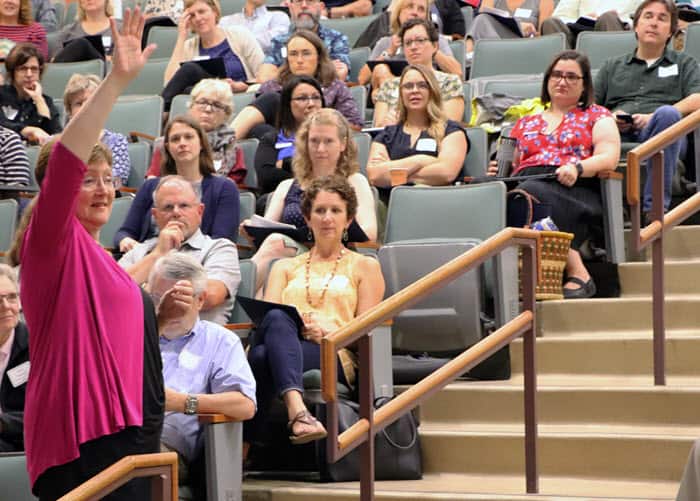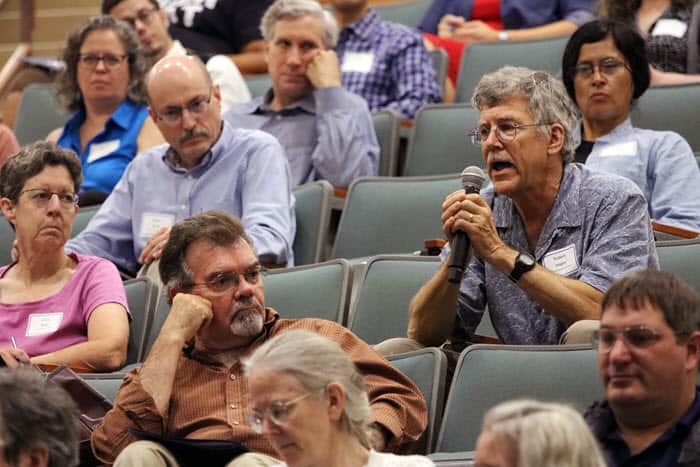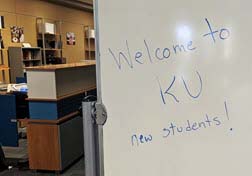
We know the story well. We helped write it, after all.
As instructors and students and administrators, we have lived the story of modern higher education. And yet, despite the familiarity of that story – or perhaps because of it – we continue to struggle with its meaning and direction.
Ann Austin, an education professor and administrator at Michigan State, told participants at KU’s annual Teaching Summit last week that that struggle is not only natural; it is also crucial as colleges and universities adapt to a landscape that has changed dramatically over the past 20 years and is poised to change even more dramatically in the next 20.
In her Summit keynote address, Austin moved among the past, present and future as she highlighted the challenges and opportunities that rapid societal changes are posing to colleges and universities. She also challenged faculty members and administrators to think philosophically and creatively about the way they teach, interact and plan.
“What kind of vision do we have in the back of our minds as we go about our day-to-day work?” Austin asked.
“What is our vision for where our learners are going, and what is our vision for the role we play in their lives?”
That vision, after all, guides us in conscious and unconscious ways, and is crucial for the success of the university. We are doing many good things, she said, but we need to be more creative in working with students, curricula and our approach to learning.
‘This noble profession’
Austin maintained an upbeat tone as she made a case that colleges and universities must change to keep pace with society. Universities are exemplars of society, places to share ideas, to advance knowledge and to debate with respect, she said. She evoked the symbolism of KU’s campus on a hill as an indication that it is “involved in something important,” or what she called “this noble profession.”

Even so, those of us who teach and work and learn and lead at universities must push our institutions to adapt and evolve. We have welcomed an increasingly diverse population of students, Austin said, and we must find better ways to support those students. Right now, she said, there’s a mismatch between social needs and educational practices and outcomes. (There is also a growing political rift over the direction of higher education.) We are doing much good, she said, but we need to do more.
“How do we create environments for the success of all?” Austin asked.
She pointed to large gateway classes as an example of where universities have fallen short. Those courses can guide students toward many types of careers – or prevent them from pursuing those careers. Nationally, half of students in those courses fail, she said, and women and students of color encounter the biggest hurdles. By embracing evidence-based teaching practices and taking a more inclusive approach to teaching and learning, though, we can lower the barriers to success.
“We know that if we change the way we go about our teaching, if we think about what will support this diversity of learners, we can pretty much get rid of that gap,” she said, citing years of research about active and engaged learning.
‘Generosity of thinking’ and other any areas of potential
Gateway courses are just one area where there is a mismatch between social needs and educational practices and outcomes, she said. Another involves soft skills, or what Austin calls “human skills”: things like communicating well; discerning between accurate and inaccurate information; understanding the context of problems and actions; engaging in teamwork and collaboration; and approaching work with integrity and ethical standards.

She also singled out something she called “generosity of thinking,” or the ability to work with people different from yourself and to seek out those complementary perspectives on projects at work and in communities.
“We really need to cultivate that even more than perhaps we do,” Austin said.
Austin drew upon her work as co-chair of the Roundtable on Systemic Change in Undergraduate STEM Education for the National Academies of Science, Engineering and Medicine. That group has highlighted the importance of a vibrant educational system and a well-educated citizenry that can join conversations on the challenges facing society. It has also focused on the needs of a changing workforce.
We know that jobs that are common today won’t exist in the future, Austin said. And in 10 or 20 years, “there will be opportunities for work that we can’t even imagine right now.”
“How do we prepare our students for this kind of world?” she asked.
What can we do?
I’ve written before about Austin, who cofounded the Center for Integration of Research, Teaching, and Learning. Her work in organizational change has influenced some of the approaches we take at CTE, and she is a partner on a National Science Foundation grant on creating a more nuanced approach to evaluating teaching. She has worked with many KU faculty members on that project, which is known as Benchmarks for Teaching Effectiveness at KU. The multi-university project is known as TEval.
Austin provides broad insight and thought-provoking questions to everything she does, and the Summit was no exception. She also offered several concrete steps that participants could take to improve their courses, their departments and the learning environments for their students:

- Embrace high-impact practices. These include things like service learning, internships, writing-intensive courses, and learning communities. These and other practices “link the knowing with the doing,” Austin said, and create a more equitable learning environment.
- “Become more fluent in how learning happens.” Research into learning and higher education continually provides new insights, Austin said, urging participants to consider ways of applying that research in their disciplines. CTE programs and materials can help instructors do that without spending hours combing through journals.
- Focus on learning, not seat time. Our courses are organized by credit hours, a system that originated in the 19th century and focused on the amount of time instructors delivered information to students. That system is outmoded, especially for online courses, but we can still work within it, Austin said, by emphasizing learning and using effective means of assessing learning.
- Seek out new ways to reach students. This might involve using technology, taking an innovative approach in face-to-face or online courses or curricula, or using new types of physical classrooms. Austin emphasized the importance of flexibility and creativity in helping students learn. Organize curricula in new ways and look for new pathways that better fit today’s students. She said that included not just degrees but ways for people to move in and out of higher education to refresh skills and share their expertise.
- Cultivate new partnerships. Communities inside and outside the university help us draw on new perspectives, learn from one another, and create new learning opportunities for our students and our colleagues. These partnerships can also provide opportunities for developing and promoting leadership skills that universities need if they hope to innovate.
Even as she pushed audience members to take action, she urged them to draw on the many good things already happening at universities.
“I’m not in any way suggesting that we just jettison what we’re doing,” Austin said. “We do so much that is so good.”
Rather, she suggested committing to effective practices and ask “what is this changing world suggesting that we might do differently?”
Doing so helps us move from story – a beacon on a hill in a volatile, changing world – to action.
“That’s the story we are part of,” Austin said. “We need to think not only in a philosophical way – that’s part of the story – but in a real practical way. What do we do in our departments, in our programs and in the university to actually let us make the best contributions to our learners and to society?”
A cloudy day with lots of sunshine

The Summit took place on the same day that hundreds of students moved in to KU’s residence halls. Chancellor Doug Girod, dressed in khaki slacks and a blue KU polo shirt, said at the beginning of the Summit that he always looked forward to helping with the move-in and talking with students and their families.
The day was cloudy, and the sky threatened rain, but school had yet to start and a shiny eagerness and a positive energy permeated the campus.
“This is one of the few days of the year when everybody smiles,” Girod said.
Doug Ward is the associate director of the Center for Teaching Excellence and an associate professor of journalism. You can follow him on Twitter @kuediting.